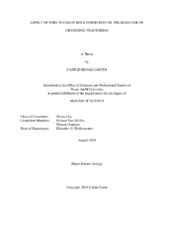| dc.description.abstract | Hydraulic fracturing has revolutionized the oil and gas industry by increasing hydrocarbon production from unconventional sources. However, waterless or reduced-water fracturing technologies have been researched due to rising concerns on the heavy use of water for hydraulic fracturing. Cryogenic fracturing is implemented by subjecting cryogenic fluid on rock formation. The idea is that a large thermal gradient, perhaps caused by evaporation of a liquified gas can induce fractures when brought into contact with a much warmer rock under downhole conditions. Rapid cooling of the rock at warm reservoir temperature will induce contraction and subsequent tensile fractures are created. Fractures created in the rocks surrounding the borehole can thus be achieved without the use of water.
Many unconventional gas formations have low water saturations, however near wellbore water saturation can be present from prior drilling and completion operations. This study investigates the effect of the presence of pore water in rock formation on the practice of cryogenic fracturing. Although we understand cryogenic fracturing can create fractures in reservoir rocks, the effect of water in the pore space of reservoir rocks has not been fully investigated. The freezing of water in formations can play a competing role with contraction of the rock, as the volume of water expands by 9% upon freezing.
This thesis reports results from a laboratory study of cryogenic fracturing in water-saturated specimens. Liquid nitrogen was utilized to create a strong thermal gradient generating local tensile stress in submersion tests and in the saturated rocks surrounding a borehole. We have developed experimental setups and procedures to conduct cryogenic fracturing tests without confining stress. Cubic blocks (8ʺ×8ʺ×8ʺ) of Berea Upper Grey sandstone and concrete were
iii
tested. Cryogen transport, measurements, and fracture characterization were integrated in experimental setups. Borehole pressure, liquid nitrogen, and temperature can be monitored during experiments. Acoustic signals were used to characterize fractures before and after the tests.
Cryogenic tests conducted on water-saturated specimens in boreholes in the absence of confining stress were able to create cracks on the outer surface of the specimens and alter rock properties. By comparing the results from the unstressed concrete and sandstone, we found the generation and geometry of fractures in water-saturated specimens is dependent on material properties such as permeability and pore distribution. The freezing of pore water in highly porous sandstones intensifies the damage done to the pore structure, to some extent, and favors the expansion of micro-fractures in the mineral skeleton to generate large fractures. Water in the formation expands as it freezes and can prevent cryogenic fracturing in strong, low-permeability reservoir rocks (concrete) by creating a barrier to nitrogen pressure permeation near the wellbore.
On the other hand, from submersion tests it is evident that weak rocks subjected to cryogenic fracturing, such as shale, can create fractures along bedding planes even though they have low permeability. This may be utilized to enhance gas recovery in shale reservoirs. Fractures were created by generating a strong thermal gradient in saturated sandstone and shale core specimens submerged in liquid nitrogen. Submersion time, cryogen amount, temperature, and fracture characterization were integrated in experiments. Acoustic signals were used to characterize fractures before and after tests. Saturated concrete blocks also fractured due to the strong thermal gradient generated by liquid nitrogen submersion. | en |


